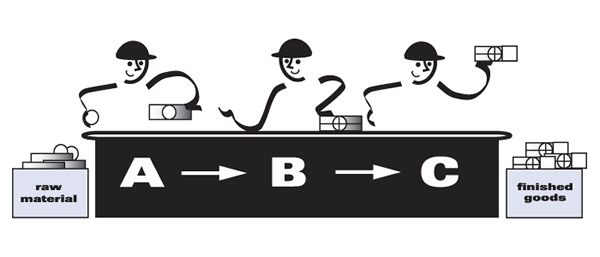The other day I began a speech to a leading supplier of medical devices by congratulating them on the absolutely level demand for their products from existing users and on the steady growth in the number of users. The audience laughed when I asked whether this meant they could plan ahead and never needed to change their plans at the last moment! Like most companies they change their plans every day, and sometimes several times a day.
They nodded in agreement that they and not their customers are responsible for the chaos these short term plan changes cause throughout their extended production and distribution system. The good news is that they ought to be able to do something about it themselves. The bad news is that if their customers knew how much extra cost this chaos causes they would be very unwilling to pay for it! The truth is that they, and many others, are still struggling to understand and deal with the underlying causes of the chaos they are dealing with. It is in fact an obstacle to their taking action to go lean.
The chaos actually begins at the customer interface. In this case the product is part of a diagnosis and monitoring process to manage a medical chronic condition. Mapping the consumption process to obtain repeat supplies will reveal opportunities for saving wasted time for the patient and for the doctor.
Mapping the way the product is ordered and delivered will reveal further opportunities for cost savings and for improving the prospect of your product being chosen rather than those of your competitors.
Mapping the way the product is ordered and delivered will reveal further opportunities for cost savings and for improving the prospect of your product being chosen rather than those of your competitors. Frequent replenishment will reduce inventories and improve availability while at the same time smoothing order signals. This analysis is too important be delegated to a distributor or wholesaler.
This chaos is then passed up the value stream towards production. In this case it takes over 200 days to reach the doctor through several decision points. Why? I am always struck by how little production people know about what happens down the distribution chain. They do not know how long the chain is, what happens closer to customers and how well the overall system fulfils customer demand. The shocking thing is that it is always longer than you imagine and levels of fulfilment from the customer’s perspective are surprisingly low, despite all the inventories in between. This is a sure sign that no one is responsible for redesigning the end-to-end value stream.
But the real culprit that is causing most of the chaos in production is the fact that our planning systems are driven by batch logic (based on economic order quantities) which depends on perfect information. We also believe we must plan every event for every product in the same way. Every time things go wrong we make a new plan and when this does not work we change it again and again. As a result fire-fighting is endemic and production efficiencies are significantly degraded.
A way out of this dilemma is to recognise the damage being done by this batch logic and to learn to see that you can in fact quickly create stability and flow for the few high volume products which account for much of your output. These need to be managed separately from the tail of build-to-order products with low volume and unpredictable demand.
Begin by creating a replenishment pull for these high volume products, absorbing demand variation in a finished goods buffer stock and initially producing them on a fixed volume, fixed sequence cycle. This creates the stability necessary to start down the lean virtuous circle of standard work and continuous improvement. It also allows much faster progress in improving equipment availability, shorter changeover times and integrating production steps into a continuous flow. Over time speed up the cycle, reduce batch sizes and incorporate more products into this flow, and as your capabilities improve vary the volume and the sequence to more closely mirror daily demand.
This path very quickly leads to increased output, near perfect on-time deliveries, much higher employee involvement in continuous improvement and it can be replicated up and down the value stream. You are no longer producing to forecast and no longer need so many planners to rejig the schedule for most of your production. And you will discover that true responsiveness comes from establishing stability and increasing the rhythm throughout the value stream, not from changing plans all the time. Chaos is not inevitable and can be conquered.
We have seen this work in so many different environments where you have a complex mix of products with variable work content or production volumes; from separating different types of service jobs in a car service shop to dealing with different types of insurance claims to separating simple routine from infrequent and difficult operations through hospital theatres.
Ian Glenday has now written a workbook to enable everyone to try out this method, called Breaking Through to Flow. This is our first LEA publication and I am confident it will help many of you take the next leap on your lean journey.






